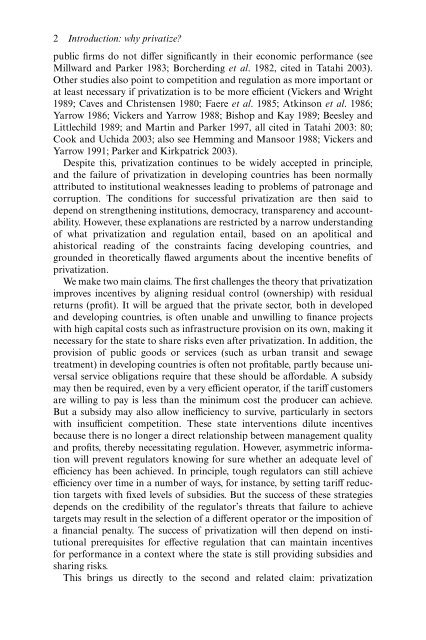PRIVATIZATION Privatization in Malaysia, Regulation, rent-seeking and policy failure
PRIVATIZATION Privatization in Malaysia, Regulation, rent-seeking and policy failure
PRIVATIZATION Privatization in Malaysia, Regulation, rent-seeking and policy failure
You also want an ePaper? Increase the reach of your titles
YUMPU automatically turns print PDFs into web optimized ePapers that Google loves.
2 Introduction: why privatize?public firms do not differ significantly <strong>in</strong> their economic performance (seeMillward <strong>and</strong> Parker 1983; Borcherd<strong>in</strong>g et al. 1982, cited <strong>in</strong> Tatahi 2003).Other studies also po<strong>in</strong>t to competition <strong>and</strong> regulation as more important orat least necessary if privatization is to be more efficient (Vickers <strong>and</strong> Wright1989; Caves <strong>and</strong> Christensen 1980; Faere et al. 1985; Atk<strong>in</strong>son et al. 1986;Yarrow 1986; Vickers <strong>and</strong> Yarrow 1988; Bishop <strong>and</strong> Kay 1989; Beesley <strong>and</strong>Littlechild 1989; <strong>and</strong> Mart<strong>in</strong> <strong>and</strong> Parker 1997, all cited <strong>in</strong> Tatahi 2003: 80;Cook <strong>and</strong> Uchida 2003; also see Hemm<strong>in</strong>g <strong>and</strong> Mansoor 1988; Vickers <strong>and</strong>Yarrow 1991; Parker <strong>and</strong> Kirkpatrick 2003).Despite this, privatization cont<strong>in</strong>ues to be widely accepted <strong>in</strong> pr<strong>in</strong>ciple,<strong>and</strong> the <strong>failure</strong> of privatization <strong>in</strong> develop<strong>in</strong>g countries has been normallyattributed to <strong>in</strong>stitutional weaknesses lead<strong>in</strong>g to problems of patronage <strong>and</strong>corruption. The conditions for successful privatization are then said todepend on strengthen<strong>in</strong>g <strong>in</strong>stitutions, democracy, transparency <strong>and</strong> accountability.However, these explanations are restricted by a narrow underst<strong>and</strong><strong>in</strong>gof what privatization <strong>and</strong> regulation entail, based on an apolitical <strong>and</strong>ahistorical read<strong>in</strong>g of the constra<strong>in</strong>ts fac<strong>in</strong>g develop<strong>in</strong>g countries, <strong>and</strong>grounded <strong>in</strong> theoretically flawed arguments about the <strong>in</strong>centive benefits ofprivatization.We make two ma<strong>in</strong> claims. The first challenges the theory that privatizationimproves <strong>in</strong>centives by align<strong>in</strong>g residual control (ownership) with residualreturns (profit). It will be argued that the private sector, both <strong>in</strong> developed<strong>and</strong> develop<strong>in</strong>g countries, is often unable <strong>and</strong> unwill<strong>in</strong>g to f<strong>in</strong>ance projectswith high capital costs such as <strong>in</strong>frastructure provision on its own, mak<strong>in</strong>g itnecessary for the state to share risks even after privatization. In addition, theprovision of public goods or services (such as urban transit <strong>and</strong> sewagetreatment) <strong>in</strong> develop<strong>in</strong>g countries is often not profitable, partly because universalservice obligations require that these should be affordable. A subsidymay then be required, even by a very efficient operator, if the tariff customersare will<strong>in</strong>g to pay is less than the m<strong>in</strong>imum cost the producer can achieve.But a subsidy may also allow <strong>in</strong>efficiency to survive, particularly <strong>in</strong> sectorswith <strong>in</strong>sufficient competition. These state <strong>in</strong>terventions dilute <strong>in</strong>centivesbecause there is no longer a direct relationship between management quality<strong>and</strong> profits, thereby necessitat<strong>in</strong>g regulation. However, asymmetric <strong>in</strong>formationwill prevent regulators know<strong>in</strong>g for sure whether an adequate level ofefficiency has been achieved. In pr<strong>in</strong>ciple, tough regulators can still achieveefficiency over time <strong>in</strong> a number of ways, for <strong>in</strong>stance, by sett<strong>in</strong>g tariff reductiontargets with fixed levels of subsidies. But the success of these strategiesdepends on the credibility of the regulator’s threats that <strong>failure</strong> to achievetargets may result <strong>in</strong> the selection of a diffe<strong>rent</strong> operator or the imposition ofa f<strong>in</strong>ancial penalty. The success of privatization will then depend on <strong>in</strong>stitutionalprerequisites for effective regulation that can ma<strong>in</strong>ta<strong>in</strong> <strong>in</strong>centivesfor performance <strong>in</strong> a context where the state is still provid<strong>in</strong>g subsidies <strong>and</strong>shar<strong>in</strong>g risks.This br<strong>in</strong>gs us directly to the second <strong>and</strong> related claim: privatization


